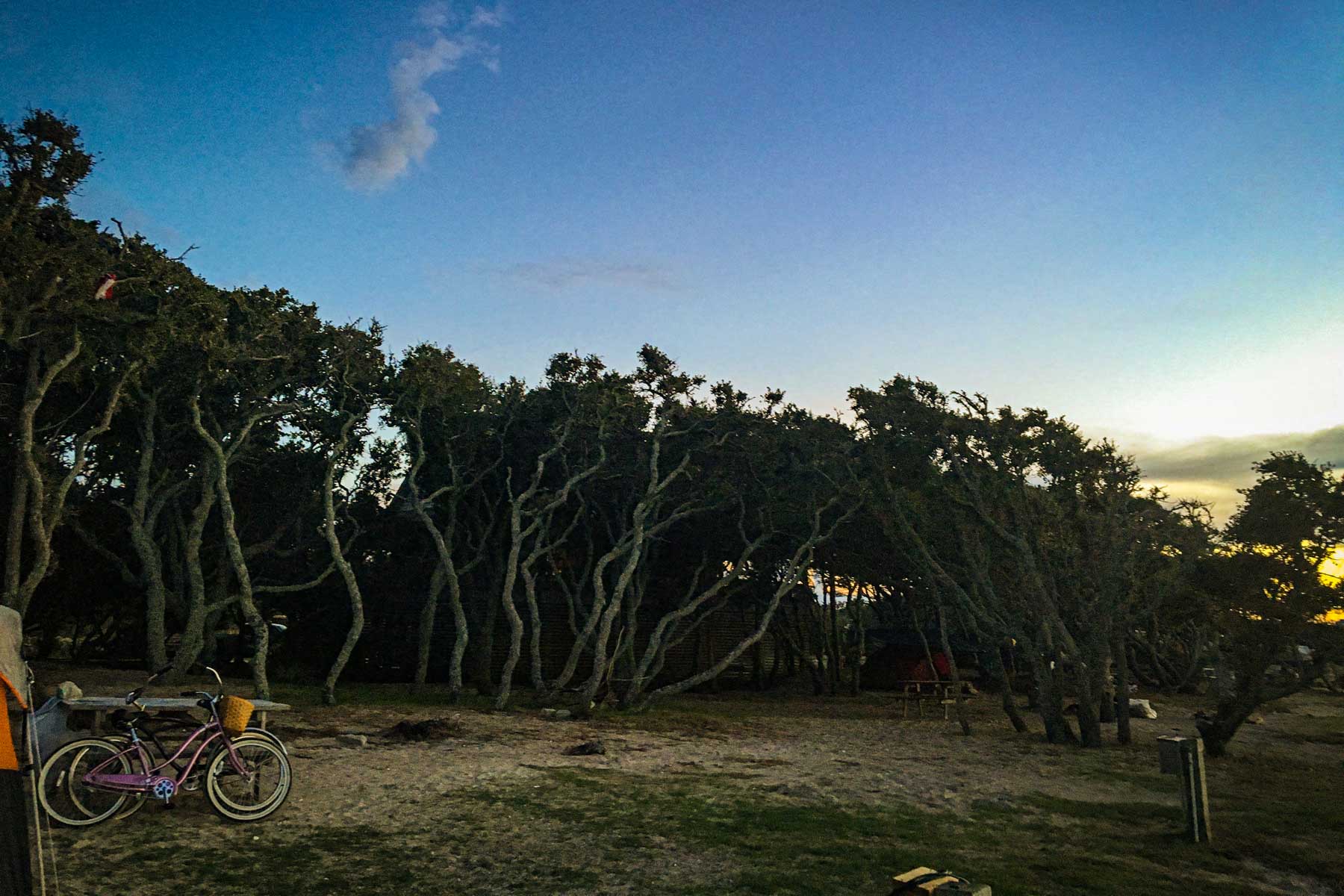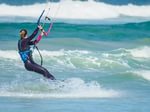Editor’s Note: Travel might be complicated right now, but use our inspirational trip ideas to plan ahead for your next bucket list adventure.
The remote Outer Banks is one of the East Coast’s most astonishing areas of peace, quiet, and natural beauty. Soaring dunes, serene maritime forests, and mile after mile of pristine sandy beaches — it’s no wonder the region is a point of pride for North Carolinians. And you can visit the dreamy, dazzling island chain without setting foot in a hotel or vacation home (or sending your savings into a nose dive). Dotting the secluded barrier islands are dozens of wallet-friendly campgrounds, from lively oceanfront compounds to sleepy soundside retreats. A successful camping trip in the Outer Banks requires tackling some logistics, so we’re here with things to know before you go, plus recommendations for popular campgrounds in the area.
Book campsites ahead.
Campgrounds give Outer Banks travelers a chance to not only see this special sheltered world, but to really live in it—just imagine unzipping your tent or stepping out of your trailer to the sound of rolling surf and the sight of billowy sand dunes and sea oats rustling in the breeze. Last-minute travelers might luck into an open site upon arrival, but it’s always safer to lay claim to your slice of island before you go. (This is particularly true during summer holiday weekends.) Campgrounds managed by the National Park Service require site-specific reservations at least three days in advance.
Know your needs.
Almost all Outer Banks campgrounds have spots for both tents and RVs. (Very few, like OBX Campground, are RV only.) It’s easy to find tent and RV sites in the Outer Banks that come with hookups for water and electricity — as well as RV sites with full hookups (water, electricity, and sewer service) — but not all campgrounds offer these utilities. More rustic properties might only have nonelectric sites for tents and RVs; the NPS-managed Ocracoke, Frisco, and Cape Point campgrounds fall into this bucket.
No tent or RV? No problem.
It’s entirely possible to experience camping in the Outer Banks without pitching a tent or owning an RV. Many campgrounds have rental cabins, cottages, or RVs permanently parked on-site as accommodation options. Cape Hatteras KOA Resort even has a large modern beach house separated into apartment-like rental suites, each with a kitchen and balcony.
Amenities, vibe, and scenery vary wildly.
More than two dozen campgrounds operate during the summer (fewer in the off-season) and every one of them is distinct. For campers who want little more than a patch of land to call their own, there are simple facilities with few to no frills — the beachfront Frisco Campground without hot water or electricity is one such option. Those looking for more bells and whistles can opt for a more resort-like compound, complete with full-utility sites and amenities like pools, game rooms, tennis courts, and general stores. (Features may be limited this year due to COVID-19.)
There’s also the matter of finding a campground with the right topography for you. If you specifically want to sleep on the sound or park yourself at the base of the beach dunes, then a bit of research and advance booking might be in order. Bear in mind that shade is not a guarantee for beach camping; consider going a bit inland on Hatteras Island if this is a priority for you. It is possible to find a site cradled in a wooded area; there are Frisco Campground tent sites tucked into an evergreen canopy, for example. Some sites, like Oregon Inlet Campground, are entirely unshaded.
Courtesy of Outer Banks Visitors Bureau, outerbanks.org
You don’t need a camping permit, but there are restrictions.
Permits are not required for camping in the Outer Banks, but you must stay in official campgrounds that are either privately owned or managed by the National Park Service. Oceanfront camping means behind the barrier dunes; camping on the beach itself is not allowed. The one exception to this rule is the very rustic, very under-the-radar Portsmouth Island, an undeveloped paradise accessible only by boat. There, you can pitch a tent right on the beach and sleep under the stars.
Nearly all campgrounds are pet-friendly.
Outer Banks campgrounds are typically very pro-dog — quite a few even have dog-friendly features like canine parks and agility courses. Caveats: Campgrounds may have fees and leash policies. Even pet-friendly properties might not allow pets in certain accommodation types, like rental cabins.
Gear up.
Of course, camping requires a bit more prep work than a holiday spent in a hotel or vacation house. Make a thorough packing checklist, including any necessary gear (tent, tarp, extra-long stakes for the sandy soil, sleeping pads and bags, lantern, flashlight, camping chairs), cookware (food, cook stove, pot, cooler, dishes, utensils, cups, mugs, tablecloth, waterproof matches, paper towels), and other supplies (rain gear, solar battery charger, pocket knife, sunscreen, tick/mosquito repellant, toiletries, first-aid kit, bottled water, binoculars for wildlife spotting, beach reads, a pack of cards). If you’re staying in a cottage or cabin, check to see if you need to provide your own linens and pillows. Consider mosquito netting and a small broom for whisking sand out of your tent, RV, or cabin.
Many campgrounds — but not all — have general stores stocked with essentials. For anything forgotten or in need of replenishment, there are produce stands, fish markets, and small local shops throughout the islands, plus several Outer Banks outposts of the big-box, North Carolina-based Food Lion grocery store.
Naturally, you’ll also need to pack beach items: swimsuits, hats, sunglasses, towels, and cover-ups. Many campgrounds have laundry facilities, so you can plan on doing a load or two rather than overthinking the clothes packing. On the shoe front, make sure to bring shower shoes and something closed-toe (and socks!) for walking, as sand spurs, prickly pear, and poison ivy might be an issue.
Plan your route.
As with any remote destination, there are logistics involved in getting to and around the Outer Banks. Accessing the 100-mile sweep of islands means crossing long, low bridges or catching ferries to secluded points otherwise unaccessible from the North Carolina mainland.
Although unlikely, bridge and road closures completely cutting off the Outer Banks are not unheard of (as was the case in the March 2020 effort to keep coronavirus at bay). A much more common issue is sticky Saturday traffic — most vacation homes are Saturday-to-Saturday rentals, and the roads can get choked with renters coming and going. Parking is free at the beaches and in the towns.
A ferry or boat crossing is the only way to reach the Outer Banks islands of Portsmouth and Ocracoke — perhaps the most charming destination in the region. The ferry scoots riders and vehicles across the inlet and into Ocracoke’s pretty harbor. Overnighters can set up camp at Teeter’s Campground, Jerniman’s Campground, or Ocracoke Campground.
Take a break from the camp stove.
One of the joys of camping is throwing dinner on the grill. But when you’re ready for a breather, consider a pickup from the islands’ local seafood spots, barbecue joints, and country-style cafes. (There’s not a national chain among them.) The SaltBox Cafe, High Cotton BBQ, and Outer Banks Boil Company have all earned a devoted following. From the latter, you can get a big pot of juicy shrimp, spicy Louisiana sausage, fresh corn, and red-skin potatoes, and steam it at camp for a traditional low-country seafood boil.
Keep up COVID-19 precautions.
Most public health experts agree that being outside is generally less risky than being indoors. Both camping and beachgoing are considered relatively low-risk — the sea breeze is an excellent natural ventilator — as long as you maintain social distancing and other safeguards, such as frequent hand-washing (or the use of disinfectant). It’s currently mandatory in North Carolina to wear a mask in public if social distancing isn’t possible. Wear a face covering when checking in at the front desk, making grocery or takeout runs, going to the bathhouse or other shared spaces, like the communal clubhouses or camp stores. Yes, you can take off your mask at the beach or in the nature preserves as long as you’re maintaining distance from others.
Courtesy of Outer Banks Visitors Bureau, outerbanks.org
Go beyond the campground.
Your Outer Banks camping vacation may be all about swimming, sunbathing, and poring over juicy thrillers on a private spot on the sand. For those who want to pepper in a bit more adventure, recommended activities include kayaking through the maritime forest and marshland at Kitty Hawk Woods Coastal Reserve and off-roading across Corolla to see wild horses roaming free. The super-intrepid can kiteboard, wreck dive, or hang glide over Jockey’s Ridge State Park — home to the tallest sand dune on the East Coast. (Even if soaring through the air in an unpiloted aircraft isn’t your thing, you shouldn’t miss sunset at Jockey’s Ridge; the towering dune is an amazing place to see the sun sink into Albemarle Sound.)
For bike lovers, cycling along the Outer Banks’ bikeways, sidepaths, and multiuse trails is a fantastic way to explore the area. Need more ideas? There are quaint coastal villages, hiking trails and ecological preserves (don’t miss Nags Head Woods Preserve), and outdoor attractions like lighthouses, beach piers, and the Wright Brothers National Memorial to check out.
Best Outer Banks Campgrounds
Ocracoke Campground
Anyone who wants a back-to-nature, off-the-grid-esque beach getaway will be delighted by Ocracoke Campground. This solitary NPS site is accessible only by ferry (as is the whole of Ocracoke), and is located about four miles from the island’s quaintly bustling harbor and village. Those who make the trek are rewarded with pretty evergreen scenery, rustic campsites at the foot of rolling dunes, and direct access to a seemingly deserted sweep of stunning beach. Tent and camper spots are nonelectric and first-come, first-serve, and the showers in the bathhouse are cold water only (rarely a problem in the heat of summer). There’s no Wi-Fi, but cell phone signal is reportedly decent.
Cape Hatteras KOA Resort
Nestled between the Pamlico Sound and the Atlantic Ocean, this pet-friendly campground in Rodanthe comes closer to a resort experience than most OBX camping spots — features include a year-round zero-entry pool, a dog park, and, most importantly, beach access. A fleet of bike, kayak, paddleboard, and golf cart rentals stand at the ready for island exploration. From the campground, it’s a short drive or bike ride to the Pea Island National Wildlife Refuge, a protected bird habitat.
Wi-Fi-equipped lodging options range from grassy tent sites (with water, electricity, a campfire ring, grill, and sheltered picnic table) to cute elevated cabins that sleep up to eight, with full baths, kitchens, and cable TV.
Cape Woods Campground
On the flip side of the bustling KOA experience is Cape Woods Campground, a chilled-out spot in Hatteras Island’s woodsy interior (a short drive or bike ride from the beach). The family-owned property has a sampler platter of ways to stay: RV sites with full hookups, tent sites, and half a dozen wood cabins. Guests happy to trade immediate proximity to the water for quiet, shady grounds will be happy at this hidden gem.
Oregon Inlet Campground
Don’t come to Oregon Inlet Campground expecting activities and amenities galore. This simple, peaceful Nags Head property — a shoo-in for fishing enthusiasts wanting to be near Oregon Inlet — has both electric and nonelectric sites for tents and RVs. A lack of shade might be a con for some.
Camp Hatteras RV Resort and Campground
This 50-acre site on Hatteras Island stretches from sound to sea, with 1,000 feet of shoreline on both bodies of water. Its long list of amenities — multiple pools, shared kitchen facilities, washer/dryers, Wi-Fi, a camp store, bike and water sports rentals, and games like tennis, shuffleboard, corn hole, and mini golf — make it especially popular with large groups and families. The majority of the lots are RV sites with full hookups, though there is a smattering of tent sites (with water and electricity) and six-person wood cottages with TVs, baths, and full kitchens.
Ocean Waves Campground
At 68 sites, this is a smaller facility with solid amenities (a swimming pool, camp store, laundry room, and hot showers) and a low-key vibe. The family-owned Ocean Waves offers a combo of electric/nonelectric tent sites and RV sites — some a stone’s throw from the dunes — with an option of tacking on cable. Sites have picnic tables but no fire pits, though beach fires are allowed in this area with a permit.
Frisco Campground
Part of Cape Hatteras National Seashore, this back-to-basics campground immerses visitors in the Outer Banks landscape of dunes, salt marshes, and shrub thickets. The camp is quiet, clean, and well-maintained, offering little more than picnic tables and charcoal grills. (No utility hookups or hot-water showers here.) Some elevated sites on the dunes have views of the ocean, though no shade; lower sites are blanketed in shady vegetation, but lack views.
Rodanthe Watersports and Campground
Laid-back, family-owned Rodanthe Watersports and Campground is located on the Pamlico Sound, letting tent campers and RVers station themselves right on the serene shoreline. Water and electricity are add-ons for those who want them. The sleepy soundside spot also rents equipment for all manner of land and water activities: bikes, stand-up paddleboards, kayaks, surf- and boogieboards, beach chairs, umbrellas, and even sailboats. Note that this is a humble, homey spot with a few dozen sites, some grills, a bathhouse, and a fish-cleaning station; it’s too small for big rigs.






Recent Comments